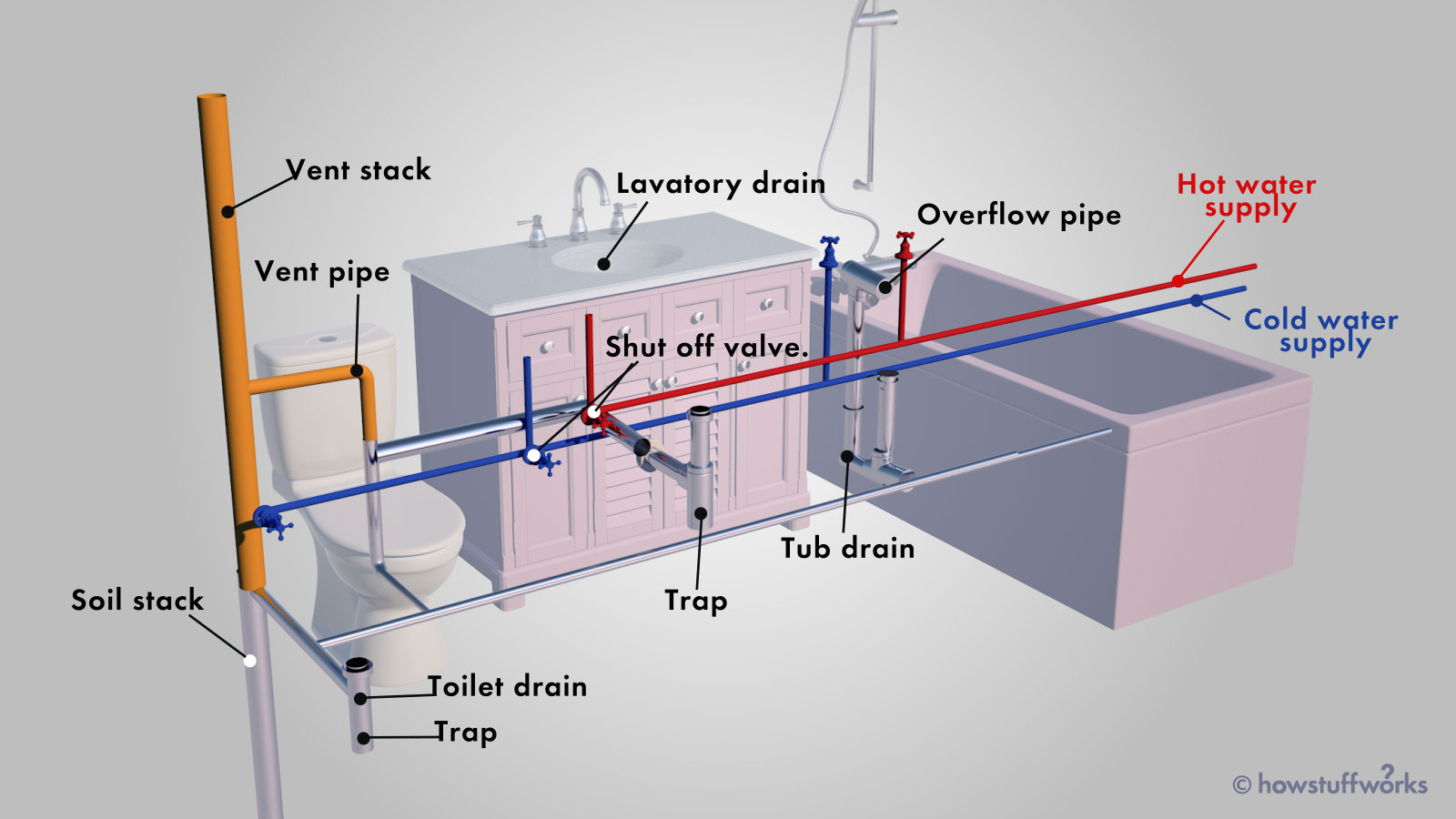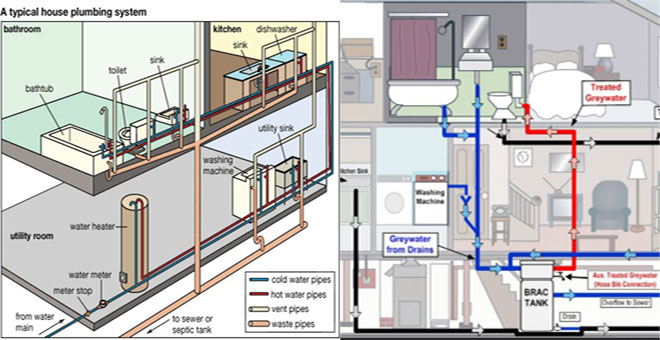What The Anatomy of Your Home's Plumbing System Matters
What The Anatomy of Your Home's Plumbing System Matters
Blog Article
Almost everyone will have their private piece of advice on the subject of Anatomy of a House: Understanding the Components.

Comprehending exactly how your home's pipes system functions is vital for every house owner. From delivering tidy water for alcohol consumption, food preparation, and showering to securely getting rid of wastewater, a well-kept pipes system is vital for your family's health and wellness and convenience. In this extensive guide, we'll discover the intricate network that composes your home's plumbing and deal suggestions on upkeep, upgrades, and managing usual problems.
Introduction
Your home's pipes system is more than just a network of pipelines; it's a complex system that guarantees you have accessibility to tidy water and efficient wastewater elimination. Knowing its elements and just how they collaborate can aid you stop costly repair services and guarantee every little thing runs smoothly.
Standard Parts of a Pipes System
Pipes and Tubes
At the heart of your plumbing system are the pipelines and tubes that bring water throughout your home. These can be constructed from various products such as copper, PVC, or PEX, each with its advantages in regards to durability and cost-effectiveness.
Components: Sinks, Toilets, Showers, etc.
Components like sinks, commodes, showers, and tubs are where water is made use of in your home. Recognizing just how these fixtures attach to the plumbing system assists in detecting issues and intending upgrades.
Valves and Shut-off Factors
Shutoffs control the circulation of water in your plumbing system. Shut-off valves are critical during emergency situations or when you require to make repair work, enabling you to separate parts of the system without interrupting water circulation to the whole house.
Water System System
Key Water Line
The major water line attaches your home to the municipal water system or an exclusive well. It's where water enters your home and is dispersed to various fixtures.
Water Meter and Stress Regulatory Authority
The water meter measures your water usage, while a pressure regulatory authority makes certain that water flows at a risk-free stress throughout your home's pipes system, preventing damage to pipelines and components.
Cold Water vs. Warm water Lines
Understanding the distinction between cold water lines, which provide water straight from the main, and hot water lines, which bring heated water from the hot water heater, aids in troubleshooting and planning for upgrades.
Drainage System
Drain Water Lines and Traps
Drain pipelines lug wastewater away from sinks, showers, and toilets to the sewage system or septic tank. Traps avoid drain gases from entering your home and likewise catch particles that could cause clogs.
Ventilation Pipes
Ventilation pipes enable air into the drain system, stopping suction that can reduce water drainage and create catches to vacant. Correct air flow is essential for maintaining the integrity of your plumbing system.
Importance of Proper Drainage
Making certain correct water drainage protects against back-ups and water damages. Consistently cleansing drains pipes and keeping catches can stop expensive repair services and prolong the life of your plumbing system.
Water Heating Unit
Types of Water Heaters
Water heaters can be tankless or typical tank-style. Tankless heating units warm water on demand, while tanks store warmed water for prompt usage.
Exactly How Water Heaters Attach to the Pipes System
Comprehending exactly how water heaters connect to both the cold water supply and hot water circulation lines assists in diagnosing concerns like insufficient warm water or leaks.
Upkeep Tips for Water Heaters
On a regular basis flushing your hot water heater to eliminate debris, inspecting the temperature level setups, and inspecting for leakages can extend its life-span and improve power efficiency.
Usual Plumbing Concerns
Leaks and Their Reasons
Leaks can take place due to maturing pipes, loosened fittings, or high water pressure. Resolving leaks promptly stops water damage and mold development.
Clogs and Clogs
Clogs in drains pipes and toilets are typically brought on by flushing non-flushable things or a buildup of oil and hair. Making use of drain displays and bearing in mind what decreases your drains can protect against clogs.
Indications of Pipes Problems to Look For
Low tide stress, slow drains, foul odors, or abnormally high water bills are indications of possible plumbing problems that must be resolved quickly.
Pipes Upkeep Tips
Regular Evaluations and Checks
Set up yearly plumbing evaluations to catch problems early. Seek signs of leaks, rust, or mineral build-up in taps and showerheads.
DIY Maintenance Tasks
Easy jobs like cleansing tap aerators, checking for toilet leaks utilizing color tablet computers, or insulating exposed pipes in chilly environments can protect against major plumbing issues.
When to Call an Expert Plumbing Technician
Know when a pipes problem calls for expert experience. Trying intricate fixings without proper knowledge can lead to even more damages and higher repair costs.
Upgrading Your Plumbing System
Reasons for Upgrading
Upgrading to water-efficient fixtures or replacing old pipelines can boost water top quality, lower water costs, and raise the worth of your home.
Modern Pipes Technologies and Their Advantages
Discover modern technologies like wise leak detectors, water-saving toilets, and energy-efficient water heaters that can save money and reduce environmental influence.
Price Factors To Consider and ROI
Compute the ahead of time expenses versus long-lasting cost savings when thinking about plumbing upgrades. Several upgrades spend for themselves via minimized utility bills and less fixings.
Ecological Effect and Conservation
Water-Saving Fixtures and Appliances
Mounting low-flow taps, showerheads, and commodes can substantially decrease water usage without giving up efficiency.
Tips for Minimizing Water Use
Basic habits like taking care of leaks promptly, taking much shorter showers, and running complete lots of washing and recipes can preserve water and reduced your utility bills.
Eco-Friendly Pipes Options
Think about sustainable pipes products like bamboo for flooring, which is durable and eco-friendly, or recycled glass for kitchen counters.
Emergency Readiness
Actions to Take During a Pipes Emergency situation
Know where your shut-off valves lie and exactly how to turn off the water in case of a burst pipeline or significant leak.
Relevance of Having Emergency Contacts Helpful
Keep call information for regional plumbings or emergency situation services conveniently available for fast action during a pipes crisis.
Do It Yourself Emergency Fixes (When Relevant).
Short-term solutions like utilizing duct tape to patch a dripping pipe or positioning a container under a dripping faucet can minimize damage till an expert plumber gets here.
Conclusion.
Comprehending the anatomy of your home's pipes system encourages you to preserve it properly, saving time and money on fixings. By complying with routine upkeep regimens and staying educated about contemporary pipes technologies, you can guarantee your pipes system operates effectively for years to find.
Understanding Your Home Plumbing System: A Comprehensive Guide
Plumbing System: The Lifeline of Your Home
At its core, the plumbing system is designed to perform two primary functions: bring fresh water into your home and remove wastewater. The system is a network of pipes, fixtures, and other components that transport water and sewage. Residential plumbing systems include potable water supply lines, drain-waste-vent (DWV) systems, and various plumbing fixtures that make water use in daily tasks possible.
Key Components:
Water Supply: This part of your plumbing system brings municipal water into your home, passing through the main water supply line. It s responsible for supplying all water needs, from drinking to bathing.
Drainage System: It carries waste and water away from your home to the sewer or septic system. This system includes all the piping within your home that leads to external sewage or septic systems.
Vent System: An essential yet often overlooked component, the vent system allows sewer gases to escape and lets air into the drainpipes, ensuring water and waste move correctly through the system.
Fixture: More Than Just Taps and Toilets
Plumbing fixtures are the most interactive parts of the plumbing system, including faucets, showers, toilets, and sinks. Each fixture is connected to the plumbing system and plays a role in either the delivery of freshwater or the disposal of waste and wastewater.
Types of Fixtures:
Faucets and Sinks: Used for washing hands, dishes, and other daily water needs.
Toilets: Dispose of human waste through the sewage system.
Bathtubs and Showers: Provide bathing facilities, requiring both hot and cold water supply.
Water Supply: The Source of Life
The water supply system is a critical component, ensuring that potable water is available throughout your home for various uses, including drinking, cooking, and cleaning. This system consists of pipes that distribute water to different parts of the house, controlled by valves to regulate the water flow.
Types of Plumbing: Materials and Methods
Various types of plumbing systems and materials are used in residential settings, each with its advantages and applications. From copper and PVC pipes for water supply to cast iron and ABS for drainage, the choice of materials can impact the longevity and efficiency of your plumbing system.
https://intownplumbingtx.com/articles/home-plumbing-system-guide/

Understanding Your Home Plumbing System: A Comprehensive Guide
Plumbing System: The Lifeline of Your Home
At its core, the plumbing system is designed to perform two primary functions: bring fresh water into your home and remove wastewater. The system is a network of pipes, fixtures, and other components that transport water and sewage. Residential plumbing systems include potable water supply lines, drain-waste-vent (DWV) systems, and various plumbing fixtures that make water use in daily tasks possible.
Key Components:
Water Supply: This part of your plumbing system brings municipal water into your home, passing through the main water supply line. It s responsible for supplying all water needs, from drinking to bathing.
Drainage System: It carries waste and water away from your home to the sewer or septic system. This system includes all the piping within your home that leads to external sewage or septic systems.
Vent System: An essential yet often overlooked component, the vent system allows sewer gases to escape and lets air into the drainpipes, ensuring water and waste move correctly through the system.
Fixture: More Than Just Taps and Toilets
Plumbing fixtures are the most interactive parts of the plumbing system, including faucets, showers, toilets, and sinks. Each fixture is connected to the plumbing system and plays a role in either the delivery of freshwater or the disposal of waste and wastewater.
Types of Fixtures:
Water Supply: The Source of Life
The water supply system is a critical component, ensuring that potable water is available throughout your home for various uses, including drinking, cooking, and cleaning. This system consists of pipes that distribute water to different parts of the house, controlled by valves to regulate the water flow.
Types of Plumbing: Materials and Methods
Various types of plumbing systems and materials are used in residential settings, each with its advantages and applications. From copper and PVC pipes for water supply to cast iron and ABS for drainage, the choice of materials can impact the longevity and efficiency of your plumbing system.
https://intownplumbingtx.com/articles/home-plumbing-system-guide/
Hopefully you liked our article on Anatomy of a House: Understanding the Components. Thanks a ton for finding the time to read through our content. Please set aside a second to distribute this blog posting if you appreciated it. I enjoy reading our article about Understanding Your Home's Plumbing Anatomy.
Get Quote Report this page